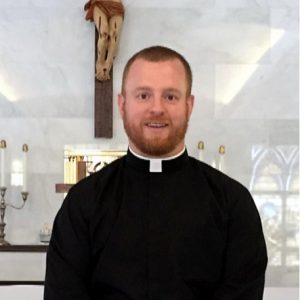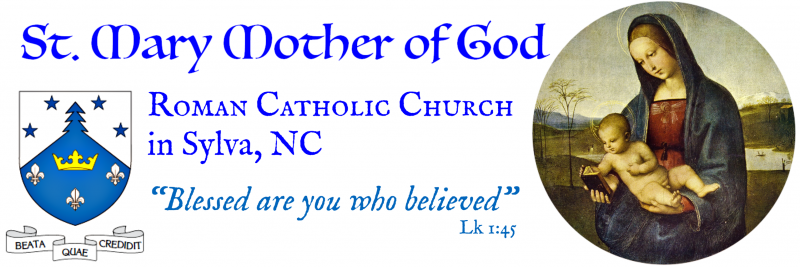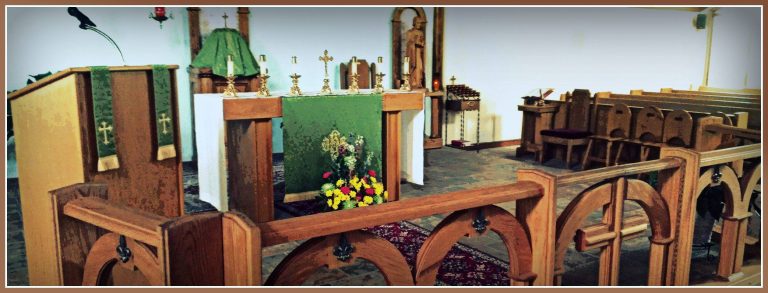From the Pastor:
 Dear Parish Family,
Dear Parish Family,
Greetings and peace to you all on the Feast of the Ascension of the Lord. This is a feast which reminds us to look to the things that are above and not here below and to continually strive to focus on Christ; to focus on Jesus most especially in the Eucharist. This understanding was recently reinforced when in our Office of Readings from the Liturgy of the Hours Pope Saint Leo the Great says:
It is upon this ordered structure of divine acts that we have been firmly established, so that the grace of God may show itself still more marvelous when, in spite of the withdrawal from men’s sight of everything that is rightly felt to command their reverence, faith does not fail, hope is not shaken, charity does not grow cold. For such is the power of great minds, such light of truly believing souls, that they put unhesitating faith in what is not seen with the bodily eye; they fix their desires on what is beyond sight. Such fidelity could never be born in our hearts, nor could anyone be justified by faith, if our salvation lay only in what was visible. And so our Redeemer’s visible presence has passed into the sacraments. Our faith is nobler and stronger because sight has been replaced by a doctrine whose authority is accepted by believing hearts, enlightened from on high.
“Our Redeemer’s visible presence has passed into the sacraments”: such beautiful words that focus us on the transcendent truth of our Lord’s presence in the Eucharist. Though He is in Heaven seated at the right hand of the Father, He remains ever with us in the Sacraments, most especially in the Eucharist.
We celebrated last Sunday as a parish the First Holy Communion of seven wonderful children who grasped with awe this profound truth. It is my goal as pastor to refocus all in our community upon the magnificent gift of the Eucharist to help us cherish it each and every time we come to the celebration of the Mass. Every time we come together to celebrate the Eucharist it is a participation of the Heavenly Liturgy through which Jesus, who is at the right hand of the Father, intercedes for us always.
[B]ut he, because he remains forever, has a priesthood that does not pass away. Therefore, he is always able to save those who approach God through him, since he lives forever to make intercession for them. It was fitting that we should have such a high priest: holy, innocent, undefiled, separated from sinners, higher than the heavens. He has no need, as did the high priests, to offer sacrifice day after day, first for his own sins and then for those of the people; he did that once for all when he offered himself (Heb 7: 24-27).
The main point of what has been said is this: we have such a high priest, who has taken his seat at the right hand of the throne of the Majesty in heaven, a minister of the sanctuary and of the true tabernacle that the Lord, not man, set up. Now every high priest is appointed to offer gifts and sacrifices; thus the necessity for this one also to have something to offer…Now he has obtained so much more excellent a ministry as he is mediator of a better covenant, enacted on better promises ( Heb 8:1-3,6).
Thus in the celebration of Mass we are present with all the heavenly host, though not visible, and because it is a participation in the one saving act of Jesus Christ on the Cross which stands outside of time and space because it is the sacrifice of God who is eternal. Thus the Mass is the meeting ground between Heaven and Earth, between time and eternity. We now on earth experience a glimpse of Heaven and when we come forward to receive Jesus in the Eucharist, He bends down to meet us and take us up into Himself, were he is seated at the right hand of the Father.
It behooves us then to take pause and to contemplate even just briefly this meeting. This is why it is so important for us now to consider what it is we do in receiving Holy Communion and how we do it.
In my experience it is easy to get into a habit of going through the motions without pausing to think about what it is that we are doing. The general practice in our parish has been for the faithful to form processional lines and each individual comes forward one by one to receive Communion, immediately returning to the pew so that the next person may receive. Before we know it our thought process is off to the next thing: “Now I have to go receive Jesus in the Precious Blood,” or, “Now I have to go back to my pew and pray.” Our mind and body go into auto-pilot not focusing on Jesus whom we have just received in our hand (if we receive in the hand). This facilitates the possibility of dropping Jesus.
It is easy to fall into the trap of treating our reception of Jesus in the Eucharist in the same way that we manage many other things in our daily lives — one more act that we have to do in our routine — and this does not allow us to pause and see how infinitely different this act really is for us. There is nothing we do that is the same. But for this to happen we need to stop and think: even if it is just a brief pause, a momentary respite to contemplate our Lord who has descended from Heaven yet again to come to us. Not only should be able to pause before hand, but we are actually called to pause as we receive Our Lord in Communion.
… As soon as the communicant receives the host, he or she consumes the whole of it (General Instruction of the Roman Missal, 161).
This means that we should pause long enough to immediately consume the host in front of the Priest, Deacon, or Extraordinary Minister of Holy Communion before we proceed to the minister who is distributing the Precious Blood of Our Lord or returning to our pew to pray. Part of the need to receive the Consecrated Host immediately is to ensure the risk of profanation of the Blessed Sacrament is as minimized as possible: i.e. dropping the host is minimized by use of the paten by the altar server, or someone with careless, ignorant, or evil intent is prevented from walking off with the Consecrated Host without consuming Jesus.
Reception of Communion in the hand and immediate consumption should be done by leaving the host as it was placed on your palm and elevating your same hand to your mouth, ensuring nothing is lost and no particles remain or are dropped in the process. Picking the host up with the thumb and forefinger of your opposite hand and placing it in your mouth, though common in practice, really should not be done. First this could be considered a form of self-communication which is only allowed by priests and bishops, because of who they are as priest acting in persona Christe. Second this provides for further transfer of particles of the host to your other hand and or particles to drop off in transition and fall to the floor, keeping in mind we should take the utmost care that to the best of our ability no particle is lost, because even down to the smallest particle of the Consecrated Host, the Eucharist is the whole of Jesus present body, blood, soul and divinity.
When receiving in the hand, the communicant should be guided by the words of St. Cyril of Jerusalem: “When you approach, take care not to do so with your hand stretched out and your fingers open or apart, but rather place your left hand as a throne beneath your right, as befits one who is about to receive the King. Then receive him, taking care that nothing is lost” (Norms for the Distribution and Reception of Holy Communion under Both Kinds in the Dioceses of the United States of America, 41).
Everything I have said thus far is presuming the reception of Holy Communion in the hand. There is less risk of these particular instances if one receives communion on the tongue, especially for the need to pause to actually consume Our Lord after reception, because practically speaking, when receiving on the tongue consummation begins at the moment of reception. Even when receiving on the tongue it is still good to be able to pause just briefly to allow your heart, mind, and soul to recognize that Jesus, whom our heart longs for, has just come to it.
Another option to receive Holy Communion besides standing on the tongue or in the hand, is kneeling.
The norm established for the Dioceses of the United States of America is that Holy Communion is to be received standing, unless an individual member of the faithful wishes to receive Communion while kneeling (Congregation for Divine Worship and the Discipline of the Sacraments, Instruction, Redemptionis Sacramentum, March 25, 2004, no. 91) (GIRM 160).
To receive Communion kneeling is a very common practice at St. Mary, Mother of God, and provides ample time to pause and discern what we are doing as we receive Holy Communion. However in the current practice of processing forward single file the draw back to the many Communicants receiving kneeling is that it slows the overall flow of reception of Communion down.
Taking all these many factors into consideration, and based on much prayer and consideration, both spiritual and practical, I wish to begin implementation of the use of the altar rail which has been a part of the sanctuary at St. Mary, Mother of God for nearly 10 years now. The use of the altar rail will provide the ability for each individual Communicant to pause before, during, and after reception of Holy Communion. Each person will still be able to receive Communion in accord with the prescribed norms as put forth by the General Instruction of the Roman Missal and the US Conference of Catholic Bishops. Each person at their discretion can receive either standing on the tongue, standing in the hand, or kneeling on the tongue. For practical and precautionary reasons, I do ask that anyone who would like to receive kneeling do so on the tongue, because the precarious position of the hands and arms at the altar rail would hinder safe reception of the Blessed Sacrament in the hand while kneeling.
What this means is that the initial communion lines will form as usual, exiting the pews and coming forward. What will change is that individuals will not have to wait for the person in front of them to finish receiving communion. Each person will find a place along the altar rail to stand or kneel and await the priest to come administer Holy Communion. Those who wish to receive communion standing can do so anywhere along the altar rail including the two wings where there is no kneeler in place. Those who would like to receive kneeling can do so anywhere along the front, including at the central gate. In either case, you may remain at the communion rail briefly after reception without feeling the need to rush immediately back to your pew.
In the end it is my firm belief that this will heighten or improve our experience of the reception of Jesus in the Eucharist here at Saint Mary, Mother of God both through providing a greater opportunity to pause and pray, recognizing what it is we are doing, and through and increased flow for the reception of Holy Communion that will shorten the overall time it takes for Communion and assist with the flow of the Mass. If anyone would have any questions or concerns please do not hesitate to contact me at (828)586-9496 or cacoleman@charlottediocese.org.
Sincerely in the love of Christ Jesus through Mary,
Fr. Casey Coleman, Pastor

